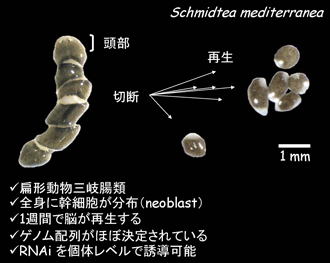Research at the SUGIYAMA lab.
I
We are interested in the application of RNA interference (RNAi) where a double stranded-RNA (dsRNA) in spicific protein complex serves as a regulatory molecule to degrade mRNA specifically. RNAi regulates gene expression in physiological condition of anmal and plant for the proper development and growth. RNAi is a natural mechanism inherited in multicellular organisms in which micro RNA (miR) expressed from genome is convered to small interference RNA (siRNA). RNAi can be led artificially by introducing synthetic siRNA to cells. Now, many kinds of siRNAs are available commercially. Down regulation of a gene expression may affect a cell function. By performing appropriate assay, we could know the role of the gene targeted by the siRNA. Thus, the siRNA is useful as a tool to investigate the gene function. We also note that the siRNA have value as a functional molecule appricable to molecular medicine.
There aremany genes which function are remained to be elucidated. We are interested in discovering a novel gene among those genes. To investigate genes and utilize siRNA, we developed a novel biotechnology. RNAi libraries containing artificial sequences are the products that we made using a new RNAi libray construction method. To perform the method, we use loop-stem-loop DNA (Figure below). The original sequences which arrayed in the molecule enabled an artistic constructon of RNAi liblary cost effectively and efficiently. Because our RNAi library contains artificial sequences, we developed a web tool "SPICE" for the sequence analysis. The bioinformatics enables to search and show information related to shRNA target chandidated genes. Thus, our laboratoy retains the uniqe research enviloment for geme-wide RNAi screening. Our goal is to synthesis and discover novel shRNA with artificial sequence for cancer cell regulation. We are interesed in the target gene to be discovered and reveal the role in cancer cell regulation.

We have succeded in obtaining a novel shRNA containig artificial sequence. The shRNA has a capability of leading to cancer cell death. The homeostasis of cancer cells were affected by the internal death signal mediated by endoplasmic reticulum stress. Our detailed investigation have succeded in finding a target gene of the shRNA. The shRNA has knocked down TMEM117 gene expression. Little was known on TMEM117 before our research. TMEM117 protein was annotated as a transmembrane protein with unknown function. We firstly have discovered TMEM117 which defined endoplasmic reticulum stress-induced cell death pathway. Our laboratory continues investigating the role of TMEM117 biologically and physiologically.
The research projects
(1) Basic and applied research on TMEM117
gene
(2) Genome-wide RNAi screening of cancer
cell death, senescence and proliferation (3) Develompment of cell-based assay using cancer
stem cell and artificial intelligence technology
We are interested in bacterium which retains novel chemical compounds and reactions. Chromium leves in soil and water
environment are strictry regulated in Japan. Bacterium in which toxic hexavalent
chromium is convereted to non-toxic trivalent chromium is useful for the
bioremediation technology of removing hexavalent chromium from heavy metal
polluted evironments. We discvored a novel bactelium which retaines such
function. In collaboration with National Institute of Technology and
Evaluation, Japan, we reveal the bacterium as a novel genus and species Flexivirga
alba ST13T (Figure below), an actinobacteril
taxon in the family Dermacoccaceae.
Chromium is a well established-material for the use on surface treatment.
Becauce of good looking and corrosion registant chromium has been an impotant
industrial material. On the other hand, it has been concerned that envilomental
pollution should not spread
from industrial activity. Thus, it is important to develop a biotechnogy to
treat waste water from factory and to remove hexavalent chromium from polluted
enviroment. Our laboratory continues to investigate F. alba ST13T for
the development of a novel bioremediation technology.
The research project
(1) Molecular biology of Flexivirga
alba ST13T
III
We are interested in planarian as a model system of regeneration. Planarian
survive after disection of body into two pieces. Head including brain
regenerates from tail tissue. The amazing characther rely on the activities of
adult stem cells. Planarin stem cell is termed neoblast. Although there are many
difference in organismal system between human and planarian, basic components
such as mitochondrial respiration are conserved. Thus, we use planarian as a
model for stem cell research on ubiquitous molecules. RNAi technology was
applied on our planarian
research which was introduced from Dr. Phillip A. Newmark laboratory.
Maintenance of planarinan in laboratory requires effort and patience. Funny
planarian looking may heal your heart. The research project (1) Effect
of antioxidants on planarian regeneration and homeostasis
Coenzume Q is a organic compound rewquired in mitochondrial respiration.
Coenzxume Q also has been known as an anitioxidant in membrane. We investigated
genes which required in the biosynthesis of coenzume Q in planarian. We succeded
in finding an important gene for the biosynthesis. Interestingly, knockdown of
the gene led to defect in planarian regeneration. Coenzyme Q levels in human
tissues is getting decreased by aging. It is interesting whether regeneration of
wound tissue of aged person rely on coenzyme Q levels. The detailed descriptin
of RNAi plaranian is available
here.
II


